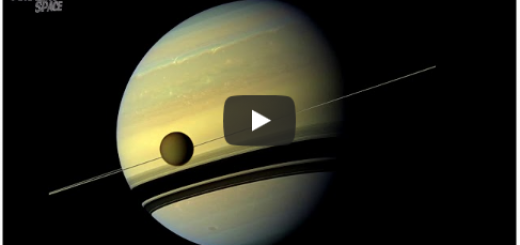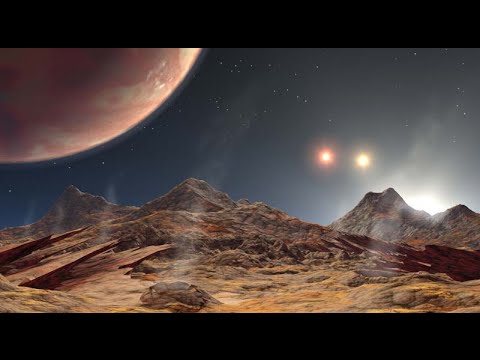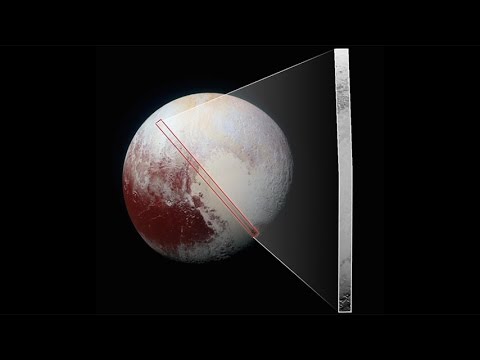The search for our solar system’s ninth planet | Mike Brown
I’m going to tell you a story from 200 years ago. In 1820, French astronomer Alexis Bouvard almost became the second person in human history to discover a planet. He’d been tracking the position of Uranus across the night sky using old star catalogs, and it didn’t quite go around the Sun the way that his predictions said it should. Sometimes it was a little too fast, sometimes a little too slow. Bouvard knew that his predictions were perfect. So it had to be that those old star catalogs were bad. He told astronomers of the day, “Do better measurements.” So they did. Astronomers spent the next two decades meticulously tracking the position of Uranus across the sky, but it still didn’t fit Bouvard’s predictions. By 1840, it had become obvious. The problem was not with those old star catalogs, the problem was with the predictions. And astronomers knew why. They realized that there must be a distant, giant planet just beyond the orbit of Uranus that was tugging along at that orbit, sometimes pulling it along a bit too fast, sometimes holding it back. Must have been frustrating back in 1840 to see these gravitational effects of this distant, giant planet but not yet know how to actually find it. Trust me, it’s really frustrating. (Laughter) But in 1846, another French astronomer, Urbain Le Verrier, worked through the math and figured out how to predict the location of the planet. He sent his prediction to the Berlin observatory, they opened up their telescope and in the very first night they found this faint point of light slowly moving across the sky and discovered Neptune. It was this close on the sky to Le Verrier’s predicted location. The story of prediction and discrepancy and new theory and triumphant discoveries is so classic and Le Verrier became so famous from it, that people tried to get in on the act right away. In the last 163 years, dozens of astronomers have used some sort of alleged orbital discrepancy to predict the existence of some new planet in the solar system. They have always been wrong. The most famous of these erroneous predictions came from Percival Lowell, who was convinced that there must be a planet just beyond Uranus and Neptune, messing with those orbits. And so when Pluto was discovered in 1930 at the Lowell Observatory, everybody assumed that it must be the planet that Lowell had predicted. They were wrong. It turns out, Uranus and Neptune are exactly where they’re supposed to be. It took 100 years, but Bouvard was eventually right. Astronomers needed to do better measurements. And when they did, those better measurements had turned out that there is no planet just beyond the orbit of Uranus and Neptune and Pluto is thousands of times too small to have any effect on those orbits at all. So even though Pluto turned out not to be the planet it was originally thought to be, it was the first discovery of what is now known to be thousands of tiny, icy objects in orbit beyond the planets. Here you can see the orbits of Jupiter, Saturn, Uranus and Neptune, and in that little circle in the very center is the Earth and the Sun and almost everything that you know and love. And those yellow circles at the edge are these icy bodies out beyond the planets. These icy bodies are pushed and pulled by the gravitational fields of the planets in entirely predictable ways. Everything goes around the Sun exactly the way it is supposed to. Almost. So in 2003, I discovered what was at the time the most distant known object in the entire solar system. It’s hard not to look at that lonely body out there and say, oh yeah, sure, so Lowell was wrong, there was no planet just beyond Neptune, but this, this could be a new planet. The real question we had was, what kind of orbit does it have around the Sun? Does it go in a circle around the Sun like a planet should? Or is it just a typical member of this icy belt of bodies that got a little bit tossed outward and it’s now on its way back in? This is precisely the question the astronomers were trying to answer about Uranus 200 years ago. They did it by using overlooked observations of Uranus from 91 years before its discovery to figure out its entire orbit. We couldn’t go quite that far back, but we did find observations of our object from 13 years earlier that allowed us to figure out how it went around the Sun. So the question is, is it in a circular orbit around the Sun, like a planet, or is it on its way back in, like one of these typical icy bodies? And the answer is no. It has a massively elongated orbit that takes 10,000 years to go around the Sun. We named this object Sedna after the Inuit goddess of the sea, in honor of the cold, icy places where it spends all of its time. We now know that Sedna, it’s about a third the size of Pluto and it’s a relatively typical member of those icy bodies out beyond Neptune. Relatively typical, except for this bizarre orbit. You might look at this orbit and say, “Yeah, that’s bizarre, 10,000 years to go around the Sun,” but that’s not really the bizarre part. The bizarre part is that in those 10,000 years, Sedna never comes close to anything else in the solar system. Even at its closest approach to the Sun, Sedna is further from Neptune than Neptune is from the Earth. If Sedna had had an orbit like this, that kisses the orbit of Neptune once around the Sun, that would have actually been really easy to explain. That would have just been an object that had been in a circular orbit around the Sun in that region of icy bodies, had gotten a little bit too close to Neptune one time, and then got slingshot out and is now on its way back in. But Sedna never comes close to anything known in the solar system that could have given it that slingshot. Neptune can’t be responsible, but something had to be responsible. This was the first time since 1845 that we saw the gravitational effects of something in the outer solar system and didn’t know what it was. I actually thought I knew what the answer was. Sure, it could have been some distant, giant planet in the outer solar system, but by this time, that idea was so ridiculous and had been so thoroughly discredited that I didn’t take it very seriously. But 4.5 billion years ago, when the Sun formed in a cocoon of hundreds of other stars, any one of those stars could have gotten just a little bit too close to Sedna and perturbed it onto the orbit that it has today. When that cluster of stars dissipated into the galaxy, the orbit of Sedna would have been left as a fossil record of this earliest history of the Sun. I was so excited by this idea, by the idea that we could look at the fossil history of the birth of the Sun, that I spent the next decade looking for more objects with orbits like Sedna. In that ten-year period, I found zero. (Laughter) But my colleagues, Chad Trujillo and Scott Sheppard, did a better job, and they have now found several objects with orbits like Sedna, which is super exciting. But what’s even more interesting is that they found that all these objects are not only on these distant, elongated orbits, they also share a common value of this obscure orbital parameter that in celestial mechanics we call argument of perihelion. When they realized it was clustered in argument of perihelion, they immediately jumped up and down, saying it must be caused by a distant, giant planet out there, which is really exciting, except it makes no sense at all. Let me try to explain it to you why with an analogy. Imagine a person walking down a plaza and looking 45 degrees to his right side. There’s a lot of reasons that might happen, it’s super easy to explain, no big deal. Imagine now many different people, all walking in different directions across the plaza, but all looking 45 degrees to the direction that they’re moving. Everybody’s moving in different directions, everybody’s looking in different directions, but they’re all looking 45 degrees to the direction of motion. What could cause something like that? I have no idea. It’s very difficult to think of any reason that that would happen. (Laughter) And this is essentially what that clustering in argument of perihelion was telling us. Scientists were generally baffled and they assumed it must just be a fluke and some bad observations. They told the astronomers, “Do better measurements.” I actually took a very careful look at those measurements, though, and they were right. These objects really did all share a common value of argument of perihelion, and they shouldn’t. Something had to be causing that. The final piece of the puzzle came into place in 2016, when my colleague, Konstantin Batygin, who works three doors down from me, and I realized that the reason that everybody was baffled was because argument of perihelion was only part of the story. If you look at these objects the right way, they are all actually lined up in space in the same direction, and they’re all tilted in space in the same direction. It’s as if all those people on the plaza are all walking in the same direction and they’re all looking 45 degrees to the right side. That’s easy to explain. They’re all looking at something. These objects in the outer solar system are all reacting to something. But what? Konstantin and I spent a year trying to come up with any explanation other than a distant, giant planet in the outer solar system. We did not want to be the 33rd and 34th people in history to propose this planet to yet again be told we were wrong. But after a year, there was really no choice. We could come up with no other explanation other than that there is a distant, massive planet on an elongated orbit, inclined to the rest of the solar system, that is forcing these patterns for these objects in the outer solar system. Guess what else a planet like this does. Remember that strange orbit of Sedna, how it was kind of pulled away from the Sun in one direction? A planet like this would make orbits like that all day long. We knew we were onto something. So this brings us to today. We are basically 1845, Paris. (Laughter) We see the gravitational effects of a distant, giant planet, and we are trying to work out the calculations to tell us where to look, to point our telescopes, to find this planet. We’ve done massive suites of computer simulations, massive months of analytic calculations and here’s what I can tell you so far. First, this planet, which we call Planet Nine, because that’s what it is, Planet Nine is six times the mass of the Earth. This is no slightly-smaller-than-Pluto, let’s-all-argue-about- whether-it’s-a-planet-or-not thing. This is the fifth largest planet in our entire solar system. For context, let me show you the sizes of the planets. In the back there, you can the massive Jupiter and Saturn. Next to them, a little bit smaller, Uranus and Neptune. Up in the corner, the terrestrial planets, Mercury, Venus, Earth and Mars. You can even see that belt of icy bodies beyond Neptune, of which Pluto is a member, good luck figuring out which one it is. And here is Planet Nine. Planet Nine is big. Planet Nine is so big, you should probably wonder why haven’t we found it yet. Well, Planet Nine is big, but it’s also really, really far away. It’s something like 15 times further away than Neptune. And that makes it about 50,000 times fainter than Neptune. And also, the sky is a really big place. We’ve narrowed down where we think it is to a relatively small area of the sky, but it would still take us years to systematically cover the area of the sky with the large telescopes that we need to see something that’s this far away and this faint. Luckily, we might not have to. Just like Bouvard used unrecognized observations of Uranus from 91 years before its discovery, I bet that there are unrecognized images that show the location of Planet Nine. It’s going to be a massive computational undertaking to go through all of the old data and pick out that one faint moving planet. But we’re underway. And I think we’re getting close. So I would say, get ready. We are not going to match Le Verrier’s “make a prediction, have the planet found in a single night that close to where you predicted it” record. But I do bet that within the next couple of years some astronomer somewhere will find a faint point of light, slowly moving across the sky and triumphantly announce the discovery of a new, and quite possibly not the last, real planet of our solar system. Thank you. (Applause)













